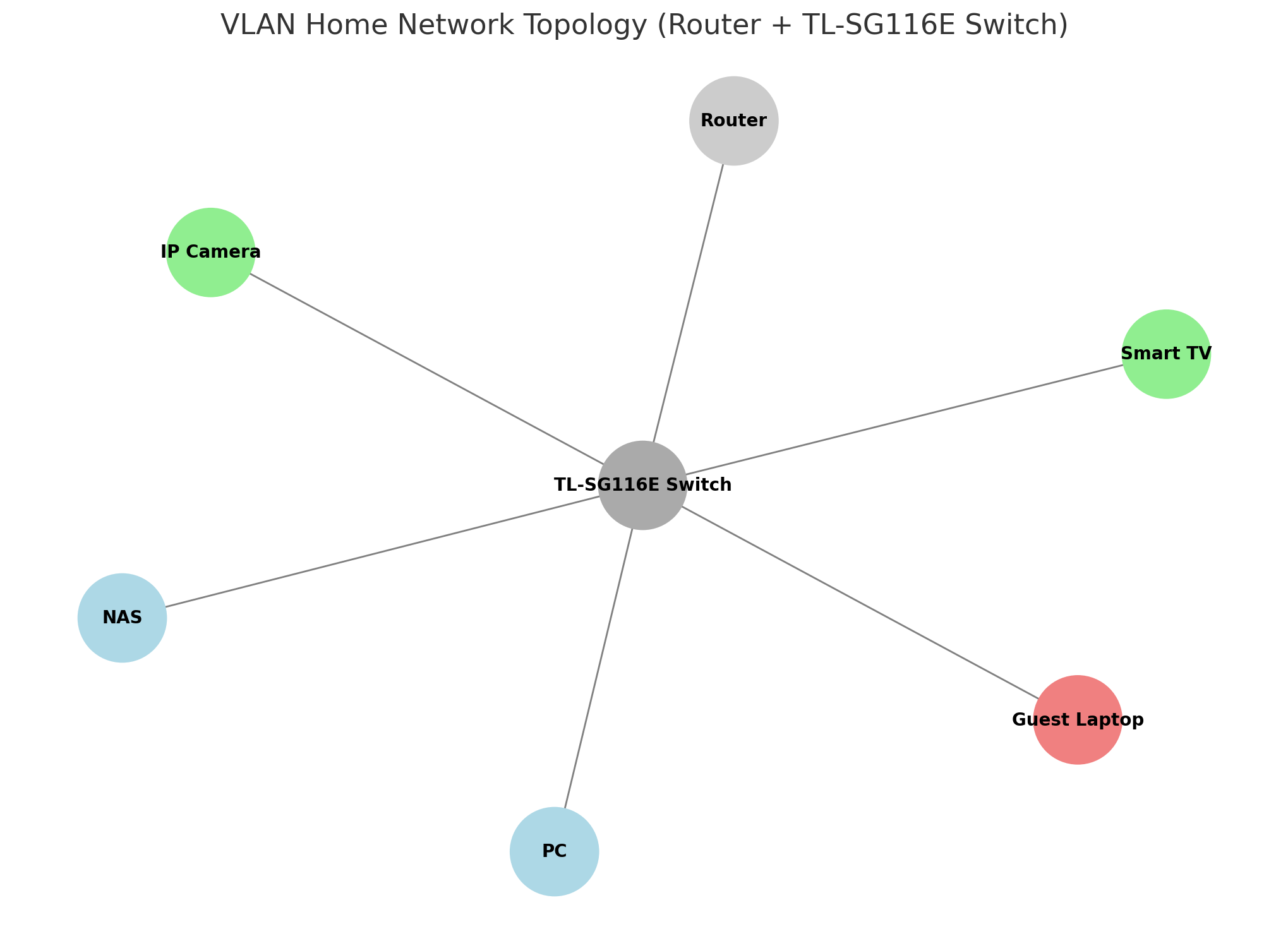Vlans At Home
Here’s a visualization of your home network VLAN setup using the TP-Link TL-SG116E switch:
- Router connects to Port 1 (Untagged VLAN 10)
- PC and NAS are in VLAN 10 (Trusted)
- Smart TV and IP Camera are in VLAN 20 (IoT)
- Guest Laptop is in VLAN 30 (Guest)
Each VLAN is isolated from the others by the switch. Let me know if you’d like a config table export or wiring diagram with port numbers!

The TP-Link TL-SG116E is a smart unmanaged switch that supports 802.1Q VLAN tagging, port-based VLANs, and PVID settings, making it suitable for basic VLAN setups even without a VLAN-aware router.
🧩 Your Setup Plan (with TL-SG116E and a non-VLAN router)
🎯 Goal: Isolate devices using VLANs
- VLAN 10: Main trusted network (with internet)
- VLAN 20: IoT devices (no access to VLAN 10, optionally no internet)
- VLAN 30: Guests (isolated from all others)
🛠️ Step-by-Step: VLAN Setup on TL-SG116E
1. Login to the Switch
- Connect a PC directly to the switch.
- Use TP-Link’s Easy Smart Configuration Utility or browser (IP is usually
192.168.0.1or192.168.0.100). - Login (default: admin / admin).
2. Create VLANs
Go to VLAN > 802.1Q VLAN > VLAN Config:
| VLAN ID | VLAN Name | Member Ports |
|---|---|---|
| 10 | Trusted | 1, 2, 3 |
| 20 | IoT | 1, 4, 5 |
| 30 | Guest | 1, 6 |
Port 1 is the uplink to your router — it must belong to all VLANs if you want them to reach the router (limited functionality unless router supports VLANs).
3. Set Port VLAN Modes (Tag/Untag)
Go to VLAN > 802.1Q VLAN > VLAN Membership:
- Port 1 (Router): Set as Untagged on VLAN 10 only (assuming router can’t handle tags).
- Ports 2–3 (Trusted): Untagged on VLAN 10.
- Ports 4–5 (IoT): Untagged on VLAN 20.
- Port 6 (Guest): Untagged on VLAN 30.
You can only assign 1 untagged VLAN per port — this becomes the PVID.
4. Set PVIDs (Port VLAN IDs)
Go to VLAN > 802.1Q PVID Setting:
| Port | PVID |
|---|---|
| 1 | 10 |
| 2–3 | 10 |
| 4–5 | 20 |
| 6 | 30 |
This ensures each port sends/receives untagged packets associated with the correct VLAN.
🔐 VLAN Isolation Behavior
- Devices on VLAN 10 (Ports 2–3) can access the internet (via Port 1 → router).
- Devices on VLAN 20 (Ports 4–5) are isolated at Layer 2 — they cannot talk to VLAN 10.
- Devices on VLAN 30 (Port 6) are isolated too.
⚠️ All VLANs share the same subnet since the router doesn’t support VLAN interfaces — so while the switch isolates traffic, the router may bridge it back if you connect all VLANs to it.
🧠 Tips & Workarounds
✅ To Block Internet for IoT or Guest Devices:
- Do not connect Port 1 (router) to VLAN 20 or VLAN 30.
- Or use static IPs and don’t configure a gateway on those devices.
✅ To Provide Internet to Multiple VLANs (Partially):
You’ll need a VLAN-aware router, or:
- Use multiple routers, one per VLAN, plugged into different VLAN access ports.
- Or set static IPs and use the same gateway (router won’t segment them, but switch will isolate traffic locally).
🛜 Wi-Fi VLAN?
Only possible if your Access Point supports VLAN-tagged SSIDs (e.g., TP-Link Omada, Ubiquiti). Otherwise, Wi-Fi clients will be in the router’s flat network.
🚦 Final Thoughts
Your TL-SG116E can enforce VLAN separation at Layer 2, even if your router is VLAN-blind. That’s great for:
- Reducing attack surface (IoT → no access to PC/NAS)
- Guest isolation
- Testing VLAN behavior
If you want full routing/firewall control between VLANs, a VLAN-aware router (like OpenWrt or pfSense) is the natural next step.